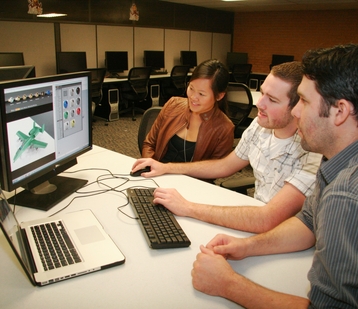
Students get high-powered engineering experience
Posted: October 28, 2010

Checking out a computer-aided design software program at the new High Performance Computing Lab are (from left) Amanda Dong, a student who works with the student outreach retention program for the Ira A. Fulton Schools of Engineering, and Nick Becker and Wes Roberts, who work for Engineering Technical Services. Photo: Blaine Coury/ASU
New lab provides access to state-of-the-art computing tools
When Christopher Karpurk had to quickly bring a group of new Daedalus Astronautics members up to speed on the club’s technological endeavors, he brought them to the new High Performance Computing Lab developed by Arizona State University’s Ira A. Fulton Schools of Engineering.
He’s helping lead members of the student engineering club in their preparations for a national rocketry competition organized by the National Aeronautics and Space Administration.
The computing lab is enabling him to train them with the use of advanced three-dimensional computer-aided design software.
“They were all excited to learn about the software program, and more excited when they learned they can use this lab,” he says.
Karpurk, a sophomore in aerospace engineering, was one of the students school administrators surveyed to get ideas for designing and equipping the lab.
“We had student ‘town hall’ meetings and other talks with students to solicit ideas on enhancing their engineering educational experience,” says James Collofello, associate dean of Academic and Student Affairs for the engineering schools. “We got the message that one thing they wanted most are opportunities and facilities to do real engineering.”
High on the list were “powerful computers that allow them to run software packages that they can’t run on their laptops, and facilities that make it easy for students to do teamwork,” Collofello says.
Students’ suggestions were taken into account on everything from the physical layout of the lab space to the furniture.
“You can see how the ideas we students had went into the planning, because they improved on the initial designs” Karpurk says. “Now it has individual work stations and group work stations, things everyone can use, from students doing their senior-year design projects to students in the beginning engineering classes.”
Opened at the start of the fall 2010 semester, it offers 23 work stations with access to state-of-the-art computer hardware and software that provides high-speed, high-capacity processing with advanced visualization, computer modeling and computer-aided design capabilities.
“The software is the type designed specifically for work that engineers do, and the computer processing is the fastest you can find on campus,” explains Julene Cahoon, a computing manager for Engineering Technical Services who is overseeing the lab. “They are especially good for mechanical, electrical, civil and construction engineering.”
Students can get technical support from lab assistants from 9 a.m. to 5 p.m. Monday through Friday. The lab is located at the Engineering Center, Room G-150.
The High Performance Computing Lab is one of the first of a series “eSpace Engineering, Innovation and Experience” learning facilities being developed by ASU’s engineering schools.
Associate dean Collofello says more “eSpace” facilities should be ready within the next year.



































